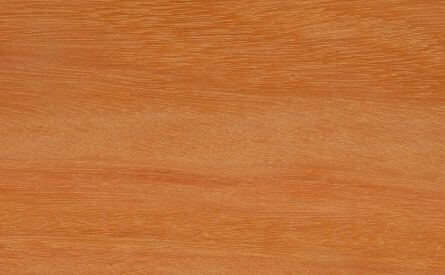Mylady
Malerio / Aspidosperma megalocarpon

Local Names
Colorado, Pelmax, Cañamito, Bayo, Chaperno, Volador, Manglillo, Alcarreto, Kromanti Kopi, Jacamim, Piquiá Marfim, Canjilón, Araracanga, Quillo Caspi
Distribution & Tree
Mylady (known as malerio in Peten and cañamito in Izabal) is widely distributed across most of the Neotropics, including Mexico, Central America and into the higher, humid forests of the Amazon. The tree has a large canopy, standing up to 35 meters with diameters that can reach a meter. The trunk is straight and often clear of branches over two-third of total tree height.
Wood Appearance
Mylady is light brown and has a uniform texture. Its heartwood is bright orange-red to reddish-brown when freshly cut becoming light pinkish-brown or pale yellowish-brown upon exposure and drying. The sapwood is yellowish and not clearly differentiated from the heartwood. The grain can be straight to irregular and the wood has a medium, uniform texture with a shiny gloss. It’s comparable to American beech, yellow birch, white ash, maple, white oak and is particularly similar to honey locust. Mylady rates better for rupture and elasticity than these substitutes.
Processing Properties
The wood machines well and rates well in all operations. Mylady finishes smoothly and takes a high polish. The heartwood is very durable in its resistance to both white-rot and brown-rot fungi. Preservation is good in both pressure-vacuum and bath treatments. It has moderate splitting and good screwing characteristics. Sawing, planning and sanding are all reported as easy and yielding good results.
Strength & Durability
Mylady is quite durable with very good dimensional stability and high lateral hardness. It’s rated as very durable against fungi and dry-wood borers, and moderately durable against termites. It is durable in the ground and fresh water contact.
Wood Uses
Its stability makes it suitable for high-end cabinet work, decking, cladding, pergolas and other exterior structures. Mylady is used for interior work, paneling, furniture, flooring, turnery, railway crossties, and tool handles. It’s used in heavy construction including bridges, mine supports, heavy containers and boat keels, planks, decks and ribs. As it has good durability freshwater durability, it’s used in bridges and hydraulic works.
Ecological & Social Importance
Mylady is a highly prized commercial species in Peru and Ecuador. Due to over-logging and irregular seeding, which occur only every other year, it is unlikely to regenerate faster than the rate of extraction and has been proposed as a candidate for reforestation in sensitive watershed areas to ensure stable stocks.
| Reference Species | ||||
| Technical Characteristics | Mylady | Hickory (Shagbark) | Sugar Maple | |
| Density | kg/m3 | 785 | 800 | 710 |
| Janka Hardness | kgf | 840 | 853 | 658 |
| Bending Stiffness (Modulus of Elasticity) | GPa | 13.8 | 14.9 | 12.6 |
| Bending Strength (Modulus of Rupture) | MPa | 152.1 | 139.3 | 109.0 |
| Crushing Strength | MPa | 88.5 | 63.5 | 54.0 |
| Shrinkage, Radial | % | 5.8% | 7.0% | 4.8% |
| Shrinkage, Tangential | % | 9.3% | 10.5% | 9.9% |
| Shrinkage, Volumetric | % | 16.5% | 16.7% | 14.7% |
| T/R Ratio | 1.6 | 1.5 | 2.1 | |
| Values determined at 12% humidity | ||||
|---|---|---|---|---|
DENSITY
JANKA HARDNESS
BENDING STIFFNESS
BENDING STRENGTH
CRUSHING STRENGTH
SHRINKAGE
Values are for reference only and cannot be guaranteed. Wood is a natural material and physical and mechanical properties may vary depending on age, genetics, and other factors. We encourage customers to consult the references provided in the bibliography. For further explanations of wood’s key technical characteristics, an excellent resource is the Wood Database with articles on Density (average dried weight); Janka hardness; Elastic Modulus; Rupture Modulus; Crushing Strength; Radial, Tangential and Volumetric Shrinkage.






